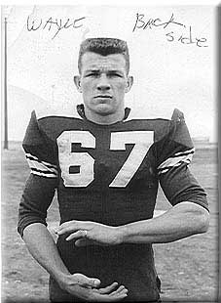All State Half-Back Finishing Strong
Wayne Lenhart is a 64 year-old retired sheetmetal worker and small business owner who was diagnosed with malignant pleural mesothelioma in September of 2000. He and his wife Pat reside in Irvine, California. As the pictures on this page illustrate, mesothelioma has waged a painful war against Wayne's body. His weight has dropped from 180 to 140 pounds. But despite the daily assault, Wayne is fighting back. As he says, with a fierceness in his eyes that dispels any hint of joking around: "I come from a long line of fighters. We don't quit."
In 1955, Wayne left Oklahoma to come to work in Los Angeles. He left behind a promising football career. Wayne was an all-state halfback and star sprinter, clocking a best of 9.9 seconds in the 100 yard dash -- which is blazing even by today's standards. Football opened many doors for Wayne. In his senior year, he was offered scholarships from 22 major NCAA schools, including the University of Oklahoma. As much as he loved sports, Wayne had a more important calling. He married his high school sweetheart and they moved to Los Angeles to raise their child.
Wayne joined the Sheetmetal Workers union upon arrival. When the scouts at the University of Southern California heard that Wayne was in town, they beat a hasty path to his door, hoping to make him a Trojan. The offers were tempting, but in the end Wayne heard the call of duty. Work before play. Family first. Pay your own way. No shortcuts.
Over the next 30 plus years, Wayne helped build hundreds if not thousands of buildings, including airports, courthouses, skyrises, hotels, industrial plants, shopping malls, hospitals, schools and colleges. While helping provide for his family and build a better city, Wayne unfortunately inhaled billions of asbestos fibers, which lay dormant in his lung linings for years.
Symptoms Appear in June of 2000
The asbestos reared its ugly head in June of 2000.
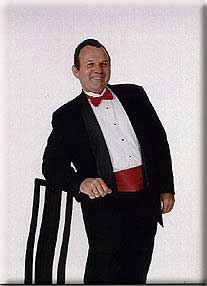
Wayne, who sold his sheetmetal company a few years before, began to noticea soreness in his right shoulder. He went to his primary care doctor, Dr. Shawn Hamilton of Irvine, California. She thought Mr. Lenhart might have tendinitis, ordered a chest film, and prescribed physical therapy. Mr. Lenhart's health plan required pre-approval for the chest film, so there was a delay of about a week. The chest film was taken at Irvine Regional Hospital and Medical Center (IRHMC) in early July. Wayne was also having severe night sweats. Dr. Hamilton telephoned shortly after the films were taken and advised that "they saw something and they wanted a second x-ray." A few days to a week later, the second films were taken at IRHMC. The Lenharts met with Dr. Hamilton again. Her words were hardly comforting: "It's cancer, but don't get upset, there's all degrees of cancer."
Dr. Hamilton referred the Lenharts to pulmonologist Dr. Johnathan Adhoot. He scheduled a thoracentesis, which was performed by a Dr. Kincaid, who drained two-and-one-half liters of fluid via the back on the right side. The fluid was black. Mr. Lenhart experienced excruciating pain during the drainage. Pat recalls, "He was yelling; it was terrible for me. It was the beginning of the beginning."
Cancer Detected, But Cell Type Undetermined
The Lenharts were referred to an oncologist. Within a week the fluid had returned and was causing pressure. Pat sought emergency help for her husband and was advised to go to the Emergency Room at IRHMC. The E.R. at first refused to perform the drainage for bureaucratic reasons. Reason finally prevailed and Dr. Adhoot was called in, but he was unable to withdraw any fluid because he could not push the needle into the pleural cavity, probably because of the size of the tumor.
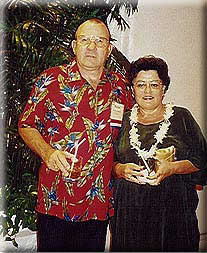
The Lenharts at this point knew they were dealing with cancer, but they did not know what kind. They were referred to a surgeon, Dr. Chino, to attempt a thoracentesis and biopsy. Dr. Chino performed a right-sided thoracotomy and repeat thoracentesis at IRHMC. Immediately after the surgery, Dr. Chino said that he had found a thick growth like a banana peel around the lung itself, which was squeezing the lung. Dr. Chino said that he believed Mr. Lenhart had mesothelioma. The Lenharts were advised that pathology had confirmed the diagnosis before his release from the hospital, six days after the surgery. His cell type was sarcomatous.
Wayne Vows to Fight, Goes to Boston
A few days after his discharge from the hospital, the Lenharts returned to Dr. Chino for removal of the staples. Dr. Chino asked Wayne, "Do you want to fight this thing?" When Wayne said he absolutely did, Dr. Chino advised Wayne to consult with Dr. David Sugarbaker in Boston to see if he was eligible for the "tri-modal" therapy of extra-pleural pneumonectomy, intraoperative chemotherapy and adjuvant radiation.
Wayne and Pat flew to Boston to meet with Dr. Sugarbaker on October 18th. Wayne's right lung had collapsed because of the encasement by the tumor, and was completely non-functional. Surgery was rescheduled for the following Monday the 23rd. The Lenharts were hopeful that Dr. Sugarbaker would remove the malignant rind around his lung, as well as any tumor cells on the margins, and slosh heated chemotherapy in the chest cavity as a final cancer cell-killing "mop up."
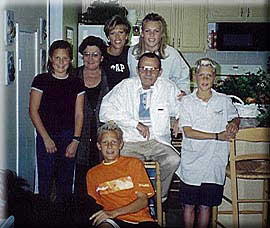
EPP Aborted Due to Huge Infection
Unfortunately, during the procedure, Dr. Sugarbaker encountered a huge empyema or puss-filled infection which forced him to abort the EPP. The doctors speculated that the infection was introduced during his initial drainage procedures back in Orange County. Dr. Sugarbaker was able to remove as much of the tumorous rind as he could see.
Wayne remained in surgical intensive care for the next several days, where he was treated for pain and also with antibiotics for the infection. Two chest tubes remained in place because he was having difficulty breathing. Wayne was finally discharged on November 2, 2000. The surgery left him weak, drawn and more determined than ever to get into the ring to tame the monster inside him.
The Challenge: Keep Weight Up and Pain Down
After their return to Irvine, Wayne and Pat have been trying to keep Wayne's weight up. He has lost about 40 pounds. The doctors prescribed megace to stimulate appetite. On top of the anorexia, Wayne was also having to cope with chronic pain, both around the incision site, as shown in these photos, and throughout the right chest cavity. Two of his local doctors recommended that he consult with a pain management doctor regarding a nerve block, which is the chemical or electrical induction of regional anesthesia that prevents sensory nerve impulses from reaching the conscious part of the brain.
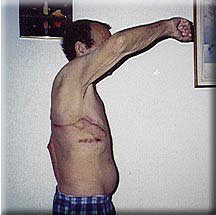
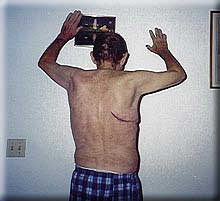
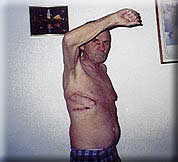
Because of the pain, Wayne cannot sit still long. Talking to him, he strikes you almost as energetic -- a wiry if not hyperactive sort who has little time for nonsense. As you can imagine, it's hard for him to stay focused mentally on any one topic for too long, as the stabs of pain are omnipresent.
Anticipating Wayne's inability to withstand a long and tedious deposition by the asbestos company lawyers, Wayne's doctors stepped up and provided testimonials that limited the length of the examination to two hours. Dr. Chino, who cited the standard prognosis of mesothelioma patients of 6 to 12 months, advised that prolonged depositions would not enhance his patient's recovery. Dr. Ahdoot concurred, writing that Wayne "has been very much debilitated due to his underlying mesothelioma as well as pain and narcotic that he is taking for pain control."
Finishing Strong
Despite the pain, weight loss, anxiety, fatigue, and shortness of breath, Wayne Lenhart is, like all great athletes, finishing strong. He will not give in to self pity. He does not demand anyone's sympathy. He does not want cheerleading, back slaps or attaboys. What he wants is simply a fighting chance. If there is hole in this tumor, like a cat-quick scatback dodging would-be tacklers, Wayne Lenhart will find a way to bust through
Wayne won't utter the words, but talking to him, you know he is imbued with an unflinching faith in his body's ability to rebound. We hear athletes on television all the time spewing shopworn cliches about "never giving up" and "staying positive." For Wayne, these are not merely cliches, they are part of his code. Wayne knows from experience that strength, honor and family are what count in this life, not empty rhetoric. He testified that what keeps him going are his family first, his love of life and a commandment deep within his genetic code that will not let a Lenhart quit.
*** POSTED DECEMBER 15, 2000 ***
Mr. Charles Lenhart passed away on May 20, 2001

